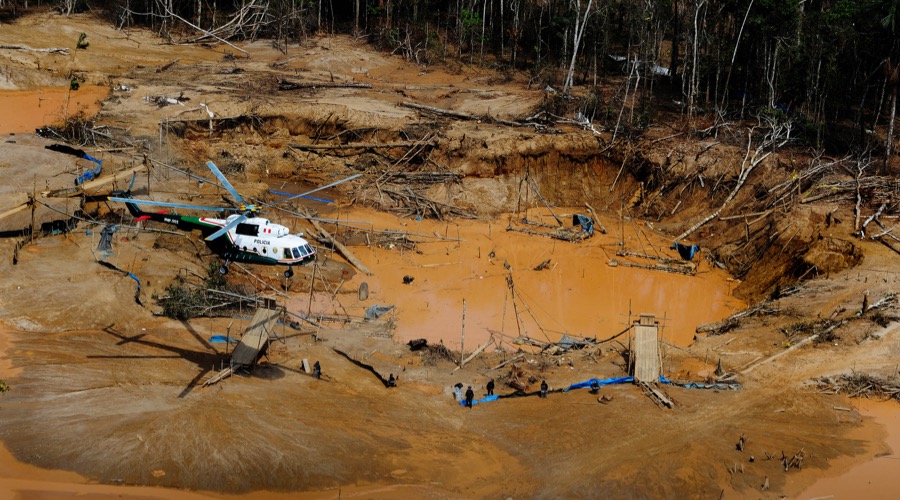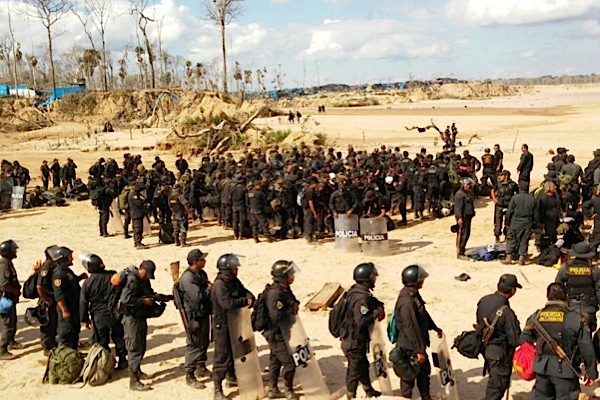
Peruvian authorities are losing their battle against an army of illegal gold miners who have carved a toxic path through the country’s rainforest, one of the most biologically diverse places on earth.
Total forest loss to date along the Santiago River is 8 hectares or the equivalent to 12 soccer fields.
According to an in-depth report by The New York Times, a force of marines and rangers sent in the past days to raid the Tambopata reserve, in the country’s southern Amazon, has already been outnumbered. And the devastated areas keep growing.
Recently released satellite images show widespread damage along a new area by the Santiago River, equivalent in size to 12 soccer fields. The once pristine waters of the stream have already turned murky brown, partly due to the fact that illegal miners use high-pressure water hoses to break down the soil.

High-resolution image of the newly deforested area due to mining activity along the Santiago River (see yellow circle). The total forest loss to date is 8 hectares (20 acres). (Images courtesy of MAAP.org —Monitoring the Andean Amazon Project | Satellite images: ©DigitalGlobe 2016)
They also use mercury, which binds with gold and forms an amalgam. The process not only exposes them to the toxic substance and its vapours, but it’s also contaminating the land and inadvertently poisoning food chains in the process.
Despite the government’s efforts to tighten the screws on illegal mining, covert gold production in the South American nation has increased fivefold since 2012, and it is estimated to provide 100,000 direct jobs in the country, 40% of which are in the Madre de Dios region, located in southern Peru.

In July last year, armed police swooped in to Peru’s Amazon basin, burning down an entire town that was home to a vast illegal gold operation.
The situation is mirrored in dozens of the countries, where gold is similarly mined and where the desperately poor often end up working in risky conditions.
In addition, neighbouring countries, such as Ecuador, have become a major transit hub for illegal Peruvian gold exported to the US, according to case files obtained by local newspaper El Comercio (in Spanish).
Peru is the world’s sixth largest gold producer and the top producing nation in Latin America, but an estimated 20% of its annual output is of unknown origin.
5 Comments
Rod B
When you look at the image above, one has to wonder where is society going? The militarized government is attacking its own people, burning it towns, trying to put 100,000 hard working people and all those that feed, house, supply them out of business! And for what?
If the miners were not mining in the jungle, where would they be? Where would they go? What would they do? Well, I guess they could clear some land and build a house to live in; they could clear some more land and raise some food to eat; they could clear some more land and raise some cattle; then they could clears some more land to make a road to market; and they could yet clear some more land so they raise a few more crops and more cattle to make a living.
Next thing you know, the militarized government will invade the farmers for CH4 emissions.
People who live in the cities do much more damage to the environment than miners do. If you add it up, as I have done, you will find that the total area of Wal-Mart + Home Depot + Sam’s Club parking lots and building footprints aggregate 157 square miles of land in the US. That number is easily doubled if you add to it the surface area of the roads constructed to access these facilities. Add to that the disturbance for all the McDonnalds, Burger King, Sears, Best Buys, and hospitals….now we’re talking mega-disturbance. Ooopps! Almost forgot to mention all that CO2 and CO emissions from the shoppers.
Makes the mining scene look like a walk in the park.
Mining Matters
While the means are questionable, you’ve got to understand these people are doing something illegally. Their mining methods are polluting the environment, including the water themselves drink! The government has offer to “formalize” them, which means they would have to pay some taxes, but also that their activity would be regulated so the destruction can be stooped and also so they can access social services provided to all workers who mine legally.
Makes sense?
Gary
I agree. If there is so much gold to be found in the region then the government should think about a formal “mining practice” where jobs,/towns can be created and that it is mined responsibly. However if there is more money to be made from illegal mining, which there probably is, then there is not much chance of anything positive happening.
walter casquino rey
This is a case in which demand for earning a living has outgrown all possible economic and social planning available in developing countries. Politicians have proved quite behind in their capabilities to build peaceful social groups. This is not new, of course, but it is sad to see that human beings are the only animals “who trip against the same rock, over and over”.
Alluvial off site mining is so common in this part of the world that the best way to organize it is to conceive and apply strong governmente regulations, something that has been already unsuccesfully tried several times. It is imperative to study everything that has not worked before and make the necessary corrections. Points to consider in this revision are:
a. HISTORY. Mining is a risky business in developing countries, because it unfolds in remote areas inhabited by impoverished peasants historically oppressed into servitude by violence who are recently being permeated by civilized take off gimmicks like TV and mobiles. History has yet to conceive ways and means to peacefully gain their trust and confidence and coalesce.
b. GEOLOGY. It will be much easier to assign mining plots if gold distribution is potentially assessed in order to determine mining areas..
c. MINING. It will be necessary to organize mining in a grid fashion, so that deforestation is orderly done considering square mining plots. Once ore is completely (?) removed, reforestation will start and ground will be completely .
d. ORE PROCESSING. One of the reasons why illegal miners affect so much ground is their technological negligence. This is not their fault. They must be taught the right way of doing it It takes a technical methodology to recover gold from ore, taking care of cautiously recovering commercial value and properly treating and disposing of tailings. Properly designed and implemented, modular hydrometallurgical processing plants either with mercury or cyanide with Merryl Crowe or activated carbon for recovery must be constructed. Modules of, at least, 1,000TPD head ore, seem appropriate. Ponds for sedimentation and detailed closure disposal for tailings will have to be considered.This takes considerable CAPEX that few private investors are willing to take, specially with the flawed regulatory frame involved.
e. COMMERCIALIZATION . Gold global marketing needs a strong networking organization that needs to be structured. This aspect might be easily solved with the right partnering.
This leaves the government as the only subject to face the problem. . But government lacks the motivation to do it because their non discretionary management style restrain them to plunge into risky projects. Building an efficient public organization to face the different and necessarily aligned aspects is needed, but this looks as an impossible dream so far. Meanwhile, peruvians will bear the cost of living with this misfortune and relying on their strenghts on other issues such as gastronomy and folklore.
Walter Casquino
.
Jérôme Dolbert
Watch my documentary film “The Rainforests Are Under Threat” – I-Tunes – https://itun.es/i67949n – A new multi-award winning documentary underscoring the threats facing this ecological treasure-trove and the people who are fighting to protect it.